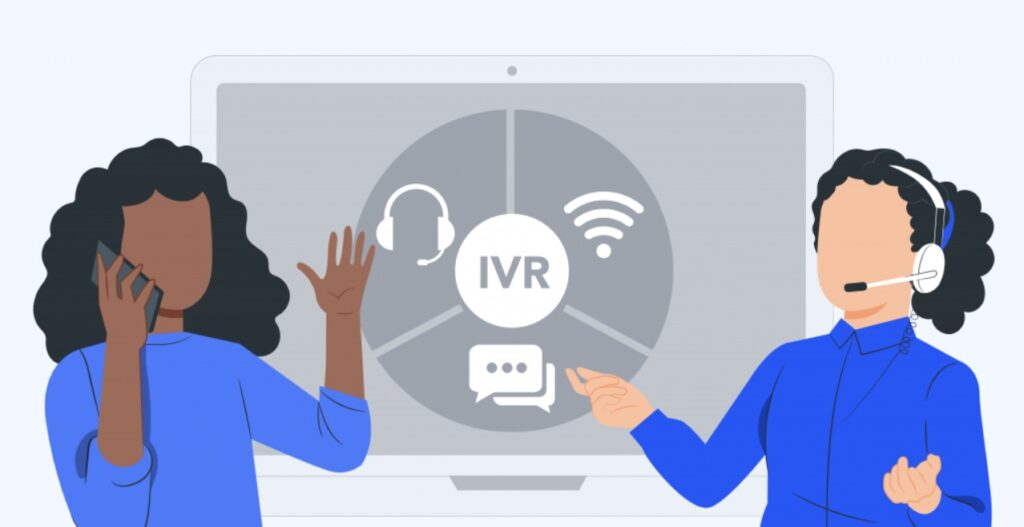What is Interactive Voice Response?
Voice IVR
Interactive Voice Response, or IVR, is an automated telephone system that combines pre-recorded messages or text-to-speech technology with a dual-tone multi-frequency (DTMF) interface to interact with callers, allowing them to provide and access information without the need for a live agent. If the IVR system cannot retrieve the information the caller is seeking, programmed menu options can provide assistance in routing callers to the appropriate representative for help. By integrating computer and telephone technologies, IVR software can improve call flow and reduce wait times, thereby increasing overall customer satisfaction.
Today, IVR software is also evolving. The development of natural language processing technology expands the variety of ways callers can interact with computers over the phone. Instead of using a tone system, more advanced IVR software allows callers to verbally state their needs over the phone. Then, through speech recognition, the IVR system can understand and respond to their inquiries in real-time.
IVR systems enhance the customer experience by providing a self-service method for customers to access the information they need, without customer support assistance. It also reduces call volumes for contact centers, thus reducing wait times and operational costs for businesses.
Benefits of Interactive Voice Response
IVR technology offers competitive advantages to businesses and advances their automation efforts. Some key benefits include:
Efficient call routing: After obtaining relevant information from a particular caller, IVR solutions channel calls to the appropriate call center agent, reducing wait times and increasing first-contact resolutions.
Lower operational costs: IVR systems are incredibly cost-effective. Not only do they reduce high call volumes for customer service representatives, but they can also extend access to information during off-peak hours of the day, such as evenings, weekends, and holidays.
Error reduction: When effectively implemented, IVR systems can reduce errors within the customer service process, as it does not rely on a human customer service representative to take notes and route incoming calls properly.
Increased security: Some IVR systems incorporate voice recognition technology to verify a person’s identity, adding an additional layer of security. This can be useful for highly confidential personal information, such as phone numbers, social security numbers, account information, and doctor’s appointment lab results.
Complexities of Interactive Voice Response
While Interactive Voice Response can offer benefits to businesses, the technology still has limitations that need to be addressed and optimized.
Overly complex IVR menu options: Despite IVR technology streamlining call flow within call centers, it can also frustrate callers if the automated messaging system is too complex. Lengthy pre-recorded messages may require callers to unnecessarily wait to select the desired option, resulting in lower customer satisfaction.
Extended wait times: Despite technological advancements, long wait times remain an issue in many IVR systems. The callback feature can alleviate frustration, as callers can continue with other tasks in their day until a customer service representative can address their request.
Impersonal communication: When customers call a support line, they may already be highly frustrated with a product or service issue. An automated messaging system can exacerbate frustration as a recording lacks the ability to empathize with their current problem.
Poorly implemented IVR systems can lead to high call abandonment rates and negative customer perception. Customer dissatisfaction can harm a brand, as they may post negative reviews and public grievances on social media. Therefore, businesses must carefully consider when implementing IVR solutions.
Conclusion
IVR is a voice channel that can serve as an outbound alternative, in a more practical and cost-effective manner. To make the most of the channel, it is necessary to have a good understanding of your database. Therefore, the more segmented the contacts are, the greater the chances of sending communications to the right people at the right time.
Through the use of integrated campaigns, the voice channel is capable of achieving a much higher efficiency rate than untargeted mass mailings.
Interested? We can help you! Channel Automation’s IVR delivers client interaction seamlessly into the rest of the conversation taking place on our dashboard. It can also be used to automatically make phone calls to your clients with status updates on their project such as, “our driver will be arriving to your house at 11:00 AM today”


